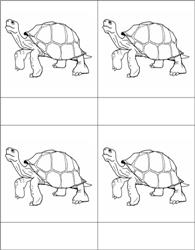I recently read an interesting article by Julia Volkman in the Jola Montessori newsletter Public Montessorian. In it, she talks about the creative limitations of having kids color outlines like those found in coloring books or blackline masters.
In Montessori, blackline masters are black and white outlines of our nomenclature cards (see the Parts of the Reptile master, below right). Traditionally, kids color in the blackline masters after matching the nomenclature cards (pictures, names, and definitions) together. They color one picture for each “part” of the plant or animal, then staple the pictures into a booklet.
Many people feel that having children color in prescribed lines stifles creativity. I don’t think it’s that simple; not all outlines are created equal. There’s a difference between a child coloring in the lines of a picture of a house and tree (when they could easily draw their own version), and a child who carefully colors in a continent map or detailed drawing of an animal’s anatomy.

Precision in Montessori
We’re not against staying within the lines when it comes to materials like the metal insets; on the contrary, we present them to the children with precision and expect them to stay “in the lines” when they use them. Many children have created stunning patterns and designs by manipulating the metal insets. Another longstanding Montessori tradition is having children copy famous works of art on their own papers.
When questioned, we offer explanations. In the case of the metal insets, the child is making the decision about how and when to draw a shape, which shape to draw, and how to fill it in. Copying famous paintings is a centuries-old practice that teaches techniques like shading, use of color, shadow, and perspective. Sounds reasonable, doesn’t it?
I Don’t Actually Use Blackline Masters (shh!)
I offer blackline masters with most of my nomenclature cards, but I’ll confess it right now: I don’t use them. In my training, we were taught to have the child either trace the drawing themselves, right on their paper, and then color it in, or draw their own representation of it, using the pictures on the cards as a guide. They then might fill in only one part and label it. For example, they might draw their own picture of a bird, color in only the wing, and then write “wing” underneath the drawing.
I find blackline masters to be fiddly: there’s a lot of copying and a lot of paper usage involved. However, I have seen examples of carefully made “parts of” booklets using blackline masters, and the child put an enormous amount of hard work into it. I don’t believe their work is diminished because they used an outline rather than drawing the picture themselves.
Keeping a Broad Definition of “Art”
Let me offer this example: when I was a 3-6 assistant, one of the older boys in the classroom took it upon himself to make a map of the United States. What he did was this: he took construction paper, traced each state on it (from the wooden map), cut each state out, and glued it on a very large piece of paper. The effect was stunning and his effort was extremely apparent.
Then, another girl in class got excited by the United States map and decided to make her own version. She asked for an outline map of the United States, gathered various colored pencils, and began to carefully shade in the states. It took her a long time to finish it, and the end result was lovely.
How could I have the artistic hubris to say that one of their maps was “better” than the other? More “artistic” than the other? There is no way I would do that. Each was a work of art in its own way.
What Is the Goal?
Anytime children use anything as a guide – be it a metal inset, the movable alphabet, the small bead frame, or a blackline master, the intent is that the material becomes a springboard to abstract work. We do not think that a child who uses the small bead frame for multiplication will never be able to do multiplication abstractly; neither does that mean a child who colors blackline masters will never be able to draw or color on their own.
I won’t be the one to say that blackline masters are good or bad. The question is too complex and has too many variables; I can’t dictate to my customers how they use the materials, and enough of you have requested blackline masters for me to know that many of you use them.
I can say this: as with anything, moderation and balance is the key. If you use the blackline masters, do so with intent. Have a purpose behind it. Perhaps a child will use the blackline masters the first time they complete the work, to make their own booklet. Maybe the next time, they will draw their own plant or animal instead. In any case, the child should be given ample opportunity to draw and paint without guidelines. In this way, the best of each method can be utilized.

